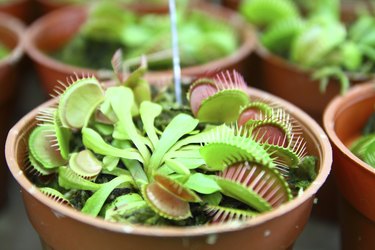
Although they've provided otherworldly fodder for horror movies, carnivorous plants won't consume you or your pets. These predatory plants manufacture their own food through photosynthesis, but they also eat insects such as mosquitoes to supplement their nutrition. Carnivorous plants use various methods to kill mosquitoes, but the end result is the same -- after a plant's digestive enzymes do their work, only the insect's exoskeleton is left behind.
Hair-trigger Venus Flytrap
Video of the Day
Venus flytrap (Dionaea muscipula), the archetypal carnivorous plant, is a Southeastern U.S. native that grows as a perennial in U.S. Department of Agriculture plant hardiness zones 5 through 8. Its scary-looking clamshell jaws form a trap, which has a hair-trigger mechanism that prompts the plant to snap shut when an insect touches the basal sensor hairs. The bait Venus flytrap uses to lure insects is its sweet nectar. Raindrops may also activate the trap-closing mechanism, but the leaves spring open once a plant detects the absence of prey.
Video of the Day
Sticky Cape Sundew
Some carnivorous plants trap insects like sticky flypaper. Cape sundew (Drosera capensis), a frost-tender perennial in USDA zones 9 through 11, has leaves covered with tiny tentacles that have sticky tips. Insects are drawn to cape sundew's sugary nectar, and they are trapped by the sticky tentacles when they land on the plants. When an insect makes contact with any tentacle, a triggering mechanism causes all the tentacles to bend in the same direction, which helps capture and hold the plant's prey. The sticky holdfasts also contain digestive enzymes.
Brightly Colored Pitcher Plant
Pitcher plants lure their prey with vivid colors and the sweet smell of their nectar. Instead of an active trapping mechanism, pitcher plants have passive traps. The round opening of the plant is at the top of a precipice that leads to a pool of water at the bottom. The nectar of yellow trumpet pitcher plant (Sarracenia flava), which grows in USDA zones 6 through 8, has a paralyzing effect on insects, causing them to slide down the slippery slope of a plant's inner tube.
An Ineffective Mosquito Control
Carnivorous plants do not control backyard mosquito populations. At best, they consume only male mosquitoes, which are not the ones that bite. It's the female mosquitoes that are the biters; they feed on blood. But the harmless male mosquitoes feed on nectar, so they are the ones your carnivorous plants attract and consume. Mosquito larvae live in standing water, which is the same environment that supports most carnivorous plants. Enjoy these unusual plants as anomalies in the plant world without building the expectation that they'll rid your backyard of mosquitoes.
Enjoy Carnivorous Plants In Captivity
These unique plant species are fun and fascinating additions to indoor potted plant collections and outdoor gardens alike as long as their modest requirements are met. Carnivorous plants have evolved a bit differently than most flora and they thrive under seemingly horrendous conditions, preferring wet, sunny and nutrient-poor environments. Always hydrate these plants with distilled water because tap water contains enough nutrients to injure or even kill your carnivorous plants.